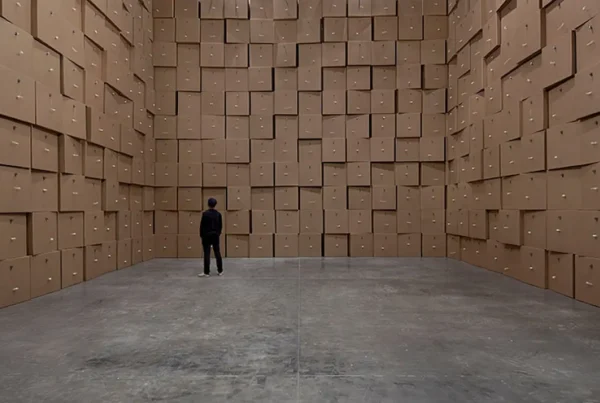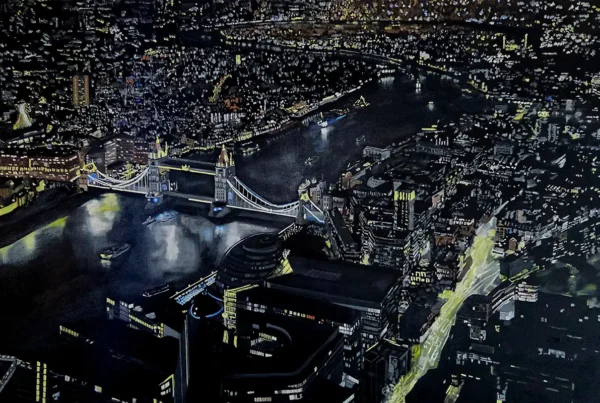Inside the Eye of the Grid
Astrid Dick’s artistic journey defies convention with a force that is both cerebral and emotionally raw. Born in Buenos Aires in 1972 and now based in Paris, she engages with painting through a vivid hybrid of forms and mediums that resist easy classification. Her work bridges the classical tradition of oil on canvas with the unpredictable shimmer of glitter and sequins, while also encompassing installation, video, and zines. Known for her fearless engagement with color and structure, Dick pushes painting beyond its historical frames, creating work that challenges the notion of genre itself. Her evolution from an MIT-trained economist to a full-time artist at the age of 36 adds an extraordinary layer of context to her practice, one where analytical rigor merges with sensory instinct.
Her paintings exist in a state of permanent negotiation—between logic and emotion, gesture and geometry, order and chaos. This is not a curated eclecticism, but a committed exploration of painting’s capacity to embody contradiction. Dick draws heavily on the legacy of modernism, yet she does so not with reverence alone but with a sense of irreverent curiosity. In her zine A True History of Stripes, she describes her work as a “disperse tapestry on the uncertain hyperplane of the personal,” a phrase that captures her resistance to confinement in formal categories. Her engagement with abstraction is never simply aesthetic—it is intellectual, psychological, and always deeply human, each canvas brimming with a tension that feels simultaneously intimate and structural.
Critics have noted the dualities at play in her work, which balances the sensual with the cerebral, and the playful with the serious. John Yau, David Rhodes, and John Vincler have all written about the energy and inventiveness of her paintings. In exhibitions across Paris and New York, Dick’s work has consistently stood out for its refusal to remain still. Her compositions breathe, collapse, and regenerate, creating a rhythm of visual thought that is at once joyful and reflective. She does not seek a singular style but rather moves through a constellation of visual vocabularies, each work contributing to a larger, ever-evolving investigation into the possibilities of painting in a fractured world.

Astrid Dick: Where the Line Breaks and Begins
Dick’s approach to abstraction is rooted in paradox, and nowhere is this more apparent than in her lifelong fascination with the stripe. Since 2016, stripes have been both a structural element and a conceptual playground in her work. In the diptych My Kitty Loves Carnival Cake (2022), vertical stripes on one panel erupt into gestural chaos on the other, with bursts of color colliding in a celebration of disobedience. Her choice of title—a blend of absurdity and affection—undercuts the seriousness of the motif while reinforcing her playful critique of artistic authority. Told she “couldn’t paint stripes” because of their saturation in modernist history, Dick responded by painting them anyway, claiming her own space within a canon she simultaneously respects and challenges.
The painting For Piet (2021) exemplifies her nuanced dialogue with art history. Referencing Mondrian’s Broadway Boogie Woogie, she isolates a section of colored rectangles, positioning them against a gesturally active upper field. Rather than a straightforward homage, the painting opens a conversation between past and present, abstraction and intuition. In Paris Bleu (2021–22), bands of cerulean and Prussian blue divide the surface with almost architectural precision, only to dissolve into fluid transitions that evoke emotion as much as structure. These visual shifts create spaces where intellect and instinct coexist, generating tension and release within the same frame.
Her work is further complicated by her use of unconventional materials. In Piétiner (Complementaries for P.M.) (2024), Dick overlays soft geometry with explosive abstraction, honoring artists like Mondrian and Mary Heilmann while asserting her own language of expressive contradiction. Rave (2024), a monumental glitter painting, appears almost monochromatic at first glance, yet reveals a hidden grid as the viewer shifts perspective. The piece oscillates between night-sky shimmer and constructed form, reminding us that perception itself is a moving target. With Stripes for Madame du Barry (2024), she sculpts discarded foam into a shaped painting that challenges not just what painting is, but what it can be made of. These experiments with surface and support are part of a broader practice that seeks out the cracks in inherited systems and plants new, unruly forms within them.

The Electric Fragility of Color
Color is not merely a formal concern in Dick’s paintings—it is a conceptual force that drives the entire composition. In Persiana Americana (2022), horizontal bands of yellow, blue, and white are interrupted by slippages of magenta and green, creating a friction between control and spontaneity. The piece feels less like a resolved image than an active proposition, one that refuses to settle into static harmony. Her brushwork shifts from confident strokes to near-translucent veils, animating the canvas with a pulse that mirrors the rhythms of thought. This shifting chromatic field becomes a site of negotiation, a visual argument between structure and surrender.
Her recent exhibition included both small and monumental pieces, created on supports as diverse as canvas, wood, mirror, foam, and even gallery floors. The tactile diversity of materials becomes part of the work’s syntax, each surface contributing a unique resonance to the visual language. Glitter, sequins, and iridescent textures, often dismissed in the art world as frivolous, are reclaimed as potent tools in her vocabulary. In Dick’s hands, these materials function not as embellishment but as resistance—against austerity, against detachment, against the sterilization of joy. They become a form of visual sabotage, blurring the line between pleasure and critique.
Dick’s film Everybody Needs a Black Square (2023) and its companion zine (2024) extend these explorations into time-based and textual mediums. Her zine, an explosive fusion of Joyce’s Ulysses and Punk Magazine, articulates her interest in fragmentation, contradiction, and saturation across forms. Just as her paintings inhabit multiple registers, her videos and writings complicate the boundaries between artist, thinker, and agitator. These works underscore her belief that art is not a discipline to be contained, but a living force that disrupts, seduces, and reconstructs. Her poetic manifesto Kamikaze Ponzi stands as a statement of both defiance and desire: an argument for art as an irrational act of clarity in a collapsing world.

Astrid Dick: Painting as a Libertine Practice
Dick’s departure from academia was not a rejection of knowledge, but a reconfiguration of how knowledge can be expressed. Her background in economics—systems analysis, abstraction, numerical logic—remains present in the scaffolding of her compositions. However, that architecture is now pushed to its expressive limits through paint. In Kamikaze Ponzi, she frames glitter as both metaphor and material, using it to evoke instability and excess. This painting, like much of her work, embodies a refusal to sanitize complexity. Instead, she constructs visual forms that are volatile, seductive, and unpredictable—paintings that feel as though they are thinking out loud.
Jean-Luc Chalumeau, reflecting on Dick’s shift from finance to painting, described her as an “expressionist talent” whose work stands apart not as trend but as temperament. Her decision to leave a decorated academic career—having won the 2012 Europlace prize for her work on finance and regulation—was driven by what she called “dismay and disgust,” a response to the disconnection between data and human suffering. For Dick, painting became a survival tool, a way to reconnect with others through the shared vulnerability of creation. Her work, according to Chalumeau, “reacts energetically against everything that is acceptance of the world as it is.” That energy animates every brushstroke, every fragment of zine text, every experimental use of foam or glitter.
Critic and painter Hugo Pernet, writing in the catalogue for Ne Pleure Pas Paillettes, frames her approach as a “fight and a game.” He points to her refusal of a “signature” aesthetic, seeing in her multiplicity not inconsistency but courage. Painting for Dick is a process of continual becoming, one that invites doubt, risk, and elation in equal measure. Her canvases are not gendered, not fixed, but singular and liberated—each one a staging ground for new visual logics. They speak in contradictions, in layered textures, in bursts of light and shadow, always resisting finality. Through this restless, intuitive process, Dick offers a kind of poetics for our disjointed era—one that embraces uncertainty as its most honest form.






